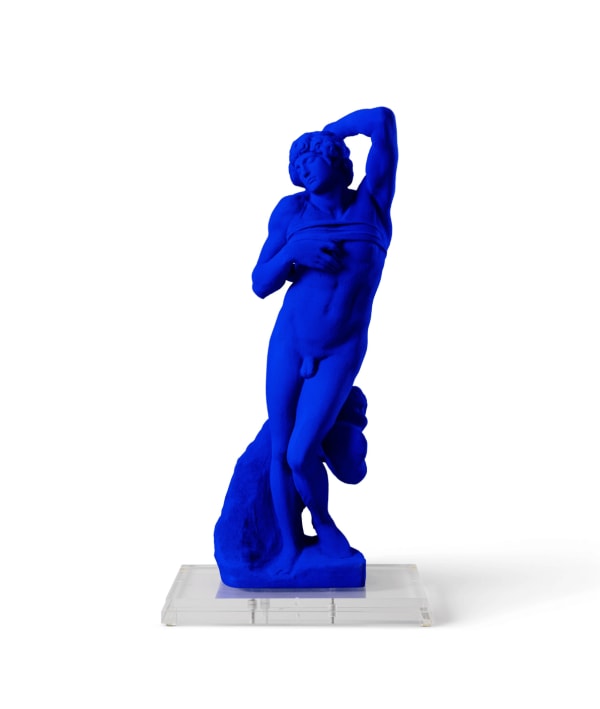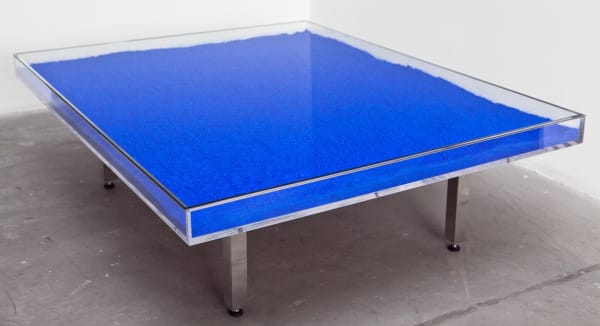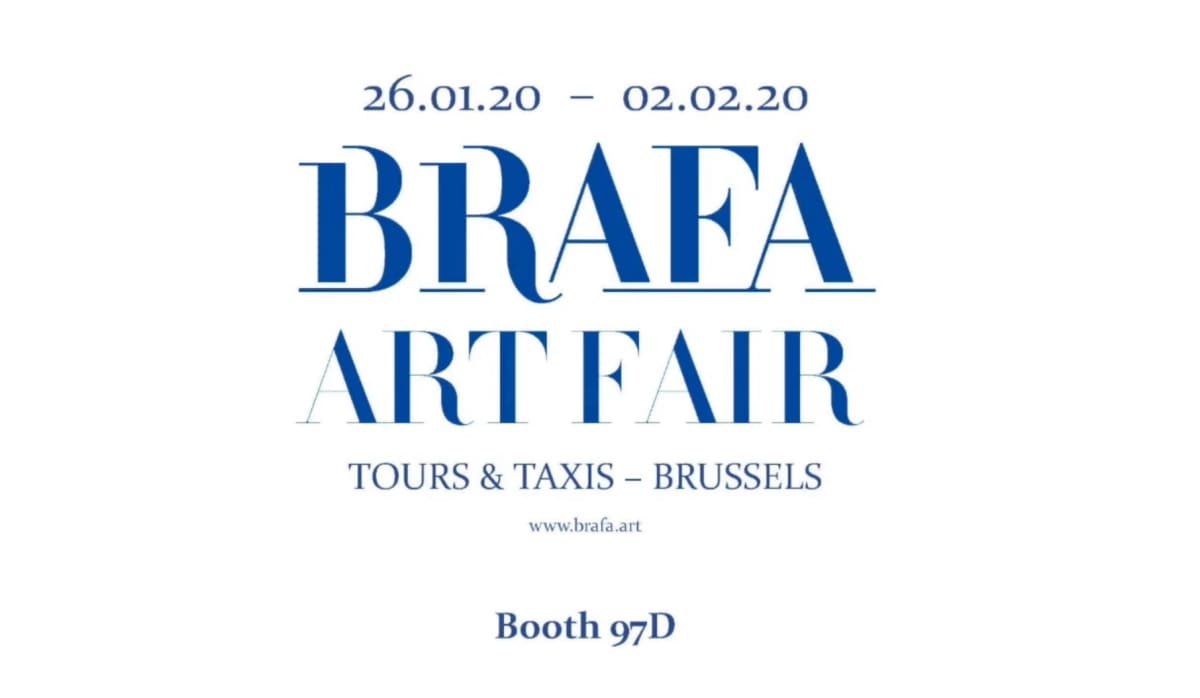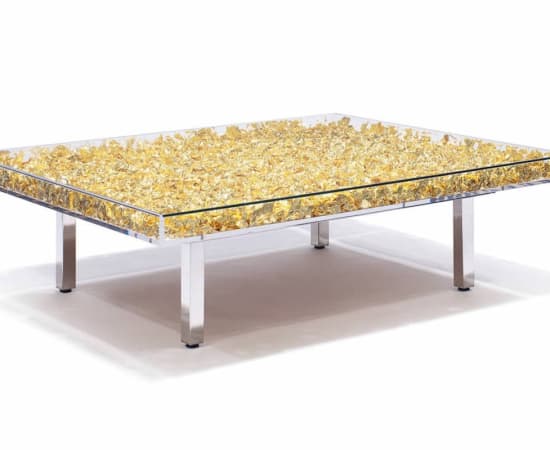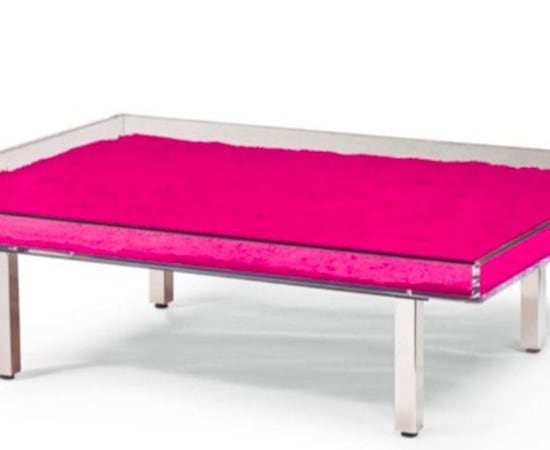Yves Klein French, 1928-1962
 Yves KleinL'Esclave mourant d'après Michel-Ange, 1962IKB Pigment and synthetic resin on plaster59 × 18 × 13 cmEdition of 300, Numbered 127/300Numbered 127/300 on the label posed on the underside, and signed R. Klein-Moquay
Yves KleinL'Esclave mourant d'après Michel-Ange, 1962IKB Pigment and synthetic resin on plaster59 × 18 × 13 cmEdition of 300, Numbered 127/300Numbered 127/300 on the label posed on the underside, and signed R. Klein-Moquay Yves KleinTable IKB® , 1961Glass, plexiglass, chrome base and IKB blue pigments.37 x 100 x 125 cmEdition de la Fondation Yves KleinSignée par Rotraut Klein-Moquay et référencée sur son cartel d'identification sous le plateau
Yves KleinTable IKB® , 1961Glass, plexiglass, chrome base and IKB blue pigments.37 x 100 x 125 cmEdition de la Fondation Yves KleinSignée par Rotraut Klein-Moquay et référencée sur son cartel d'identification sous le plateau Yves KleinTable Monogold ™, Créée en 19613000 feuilles d’or, plexiglas, verre et pieds en acier chromé37 x 100 x 125 cmCette pièce fait partie d’une édition commencée en 1963, sous la supervision de Rotraut Klein-Moquay et basée sur un modèle de Yves Klein.Signée par Rotraut Klein-Moquay et référencée sur son cartel d'identification sous le plateau
Yves KleinTable Monogold ™, Créée en 19613000 feuilles d’or, plexiglas, verre et pieds en acier chromé37 x 100 x 125 cmCette pièce fait partie d’une édition commencée en 1963, sous la supervision de Rotraut Klein-Moquay et basée sur un modèle de Yves Klein.Signée par Rotraut Klein-Moquay et référencée sur son cartel d'identification sous le plateau Yves KleinTable Monopink™ , Créée en 1961Pigment rose, Plexiglas, verre et pieds en acier chromé37 x 100 x 125 cm (49 5/8 x 15 3/8 x 39 3/8 in.)Cette pièce fait partie d’une édition commencée en 1963, sous la supervision de Rotraut Klein-Moquay et basée sur un modèle de Yves Klein.Signée par Rotraut Klein-Moquay et référencée sur son cartel d'identification sous le plateau
Yves KleinTable Monopink™ , Créée en 1961Pigment rose, Plexiglas, verre et pieds en acier chromé37 x 100 x 125 cm (49 5/8 x 15 3/8 x 39 3/8 in.)Cette pièce fait partie d’une édition commencée en 1963, sous la supervision de Rotraut Klein-Moquay et basée sur un modèle de Yves Klein.Signée par Rotraut Klein-Moquay et référencée sur son cartel d'identification sous le plateau

PAD 2025 Paris
Pavillon des Arts et du Design2 - 6 Apr 2025Fot this edition of the PAD Paris, the Galerie Jean-François Cazeau is happy to present a selection of works by Niki de Saint-Phalle, Yves Klein,...Read more
BRAFA Art Fair 2025
26 Jan - 2 Feb 2025As every year, the gallery is delighted to showcase its selection of Impressionnist and Modern works at the BRAFA Art Fair in Brussels, in an eclectic booth.Read more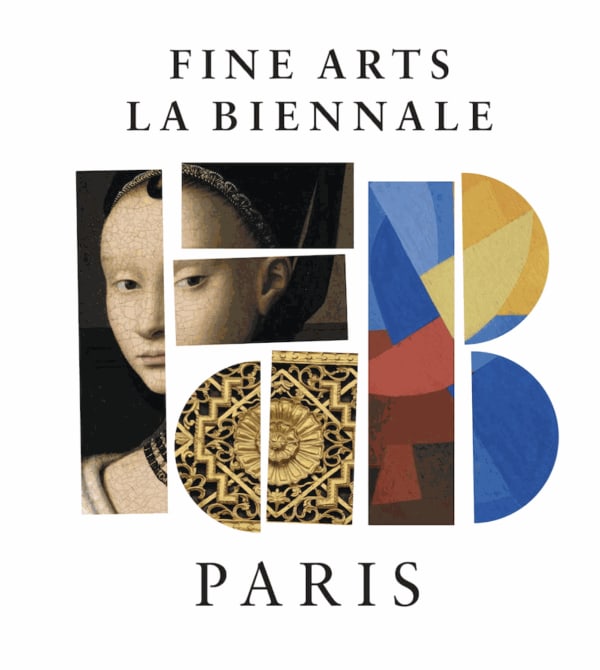
FINE ARTS - LA BIENNALE 2024
Grand Palais22 - 27 Nov 2024The Galerie Jean-François Cazeau has the pleasure to announce its participation at the 2024 edition of FAB - Fine Arts La Biennale. The prestigious art...Read more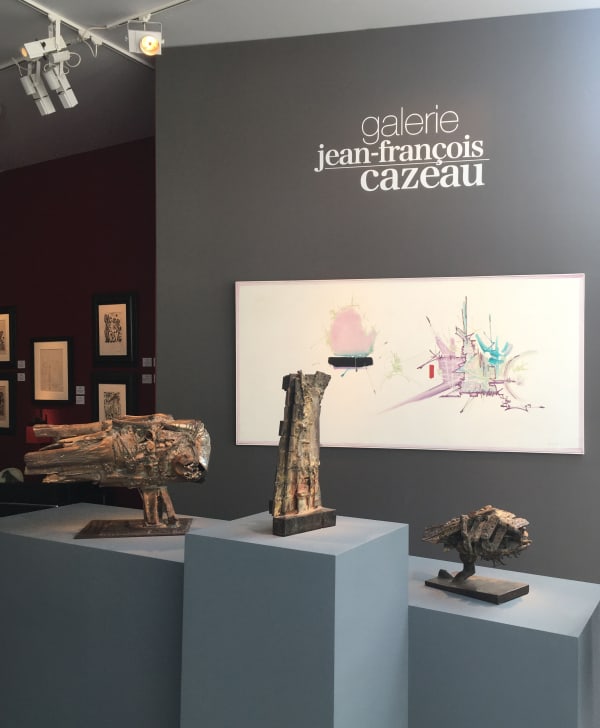
ART PARIS 2020
10 - 13 Sep 2020Art Paris 2020, the modern and contemporary art fair, is reborn at the Grand Palais from September 10 to 13. It will be the first...Read more
BRAFA 2020
26 Jan - 2 Feb 2020La Brafa est réputée pour la qualité haut de gamme des œuvres exposées, des antiquités à l’art moderne et contemporain en passant par les beaux-arts...Read more
Yves Klein was born on the 28th April 1928 in Nice. Both his parents were artists. His father, Fred Klein, was a figurative painter who exhibited from the early 1930s, and his mother, Marie Raymond, was an abstract geometrical painter whose work was renowned from 1945 on. This environment gave him a familiarity with the art world from a very early age, but Yves Klein initially chose a different career.
Even though he had painted since he was a teenager, it was always secondary to his other activities. First of all he started practicing judo in 1947, at a time when it hadn't yet been reduced to a mere sport, but was still an intellectual and moral method of teaching self-control. During one of his first lessons, he met Armand Fernandez, the future Arman. In 1952, he went to Japan to perfect his technique and he gained his black belt, 4th dan, a level that no French person had ever obtained at the time. On returning to France, the French Judo Federation refused to let him teach and he opened his own school in 1955 which he decorated with monochromes, but ended up closing it down the following year for financial reasons.
Alongside judo, Yves Klein discovered the Rosicrucian Order in 1947. His monochromes then became religious objects to him. He regularly read the 'Cosmo-Conception', the Order's founding text written by Max Heindel. The book teaches knowledge through imagination, considered to be the most powerful of human faculties. When Klein read Air and Dreams by the French philosopher, Gaston Bachelard in 1958 he found it echoed his own thoughts.
From 1955, Klein started to present works in an artistic context : he exhibited monochromes of various colours at the Club des Solitaires in Paris under the title Yves, paintings. He met the French art critic, Pierre Restany there, with whom he collaborated throughout his life : his career as a painter had been launched.
In 1957 he started his « blue period », a choice of colour that was strengthened after a trip to Assisi where he discovered Giotto's skies. He recognised in the painter the true precursor for his blue monochromy : uniform and spiritual. Klein implemented this blue monochromy, seen in Giotto's work, notably thanks to the particular texture of the paint, which was an original formula patented in 1960 : he called the paint IKB (International Klein Blue). He was an artist of international renown by this time and was among the founders of the New Realism movement, along with Restany and Arman, while still carrying out his personal research.
The blue monochromes are, however, only part of his work that also uses various other techniques. From 1960 on, Klein used gold and fire and created works which combined a trio of colours : blue, gold and pink. In January 1961, Klein registered a design for a transparent table filled with pure pigments. In the same year, he produced an ex-voto in the form of a triptych that he dedicated to Saint Rita ; he also exhibited in the same year in Krefeld in Germany, where he spread the same three colours throughout the exhibition space ; he used them for Rotraut Uecker's wedding invitation in January 1962, transforming it into a work of art.
Yves Klein died of a heart attack in June 1962.
Join our mailing list
* denotes required fields
We will process the personal data you have supplied in accordance with our privacy policy (available on request). You can unsubscribe or change your preferences at any time by clicking the link in our emails.
